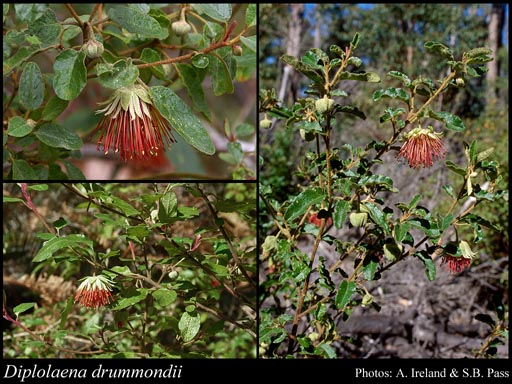- Reference
- Biol.Meddel.Kongel.Danske Vidensk.Selsk. 3(2):80 (1921)
- Conservation Code
- Not threatened
- Naturalised Status
- Native to Western Australia
- Name Status
- Current
Erect shrub, 0.5-1.5 m high, leaves oblong-elliptic, thin, mostly 2-6 cm long, involucral bracts with grey indumentum. Fl. yellow-orange-red, Jul to Nov. Sand over granite. Rocky outcrops.

Scientific Description
Shrub, spines absent; branchlets smooth, without distinct raised glands, +/- cylindrical in cross-section, covered in hairs or scales, the hairs stellate (star-shaped). Leaves opposite, simple, 15-45 mm long, 7-28 mm wide, flat, the margins flat, smooth, without distinct raised glands, covered in hairs or scales, with stellate (star shaped) hairs; stipular excrescences absent. Flowers in a distinct head surrounded by bracts, the outer bracts 9-14 mm long; pedicels 5-7 mm long; calyx minute or absent, smooth, without distinct raised glands; corolla red, yellow or orange, petals five, 8-9.5 mm long, imbricate (overlapping), free, hairy on the surfaces; stamens numerous (more than twice as many as petals), 14-20 mm long, smooth, hairy; anthers 1.3-1.6 mm long, without an appendage. Flowers in July, August, September, October and November. Occurs in the South-West Botanical Province, in the Avon Wheatbelt, Jarrah Forest, Warren and Swan Coastal Plain IBRA region(s).
Distribution
- IBRA Regions
- Avon Wheatbelt, Jarrah Forest, Swan Coastal Plain, Warren.
- IBRA Subregions
- Merredin, Northern Jarrah Forest, Perth, Southern Jarrah Forest, Warren.
- Local Government Areas (LGAs)
- Collie, Dardanup, Donnybrook-Balingup, Harvey, Kalamunda, Kwinana, Mundaring, Nannup, Plantagenet, Wandering, Westonia, York.